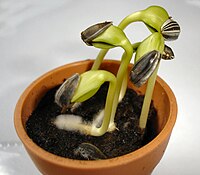
Photo from wikipedia
North African knapweed (Centaurea diluta Aiton), cornflower (Centaurea cyanus L.), corn marigold [Glebionis segetum (L.) Fourr.], rigid ryegrass (Lolium rigidum Gaudin), and corn poppy (Papaver rhoeas L.) are weeds of… Click to show full abstract
North African knapweed (Centaurea diluta Aiton), cornflower (Centaurea cyanus L.), corn marigold [Glebionis segetum (L.) Fourr.], rigid ryegrass (Lolium rigidum Gaudin), and corn poppy (Papaver rhoeas L.) are weeds of economic importance in the Iberian Peninsula, particularly due to the limited herbicide options for effective control. For this reason, information about their seedling emergence has become critical to develop effective integrated management strategies and better time control actions. The aims of this study were to evaluate the effect of seed burial depth and soil disturbance on the emergence of the aforementioned weed species. Two pot experiments were carried out to 1) quantify seedling emergence at three burial depths (2, 5 and 9 cm), and 2) characterize seedling emergence in response to different frequencies and timings of soil disturbance. Burial depth limited the emergence of G. segetum and P. rhoeas at 5 and 9 cm, respectively; while seedling emergence of C. diluta, C. cyanus, and L. rigidum were reduced by 92, 90 and 67 % at 9 cm compared to 2 cm, respectively. Two or more sequential soil disturbance events increased total seedling emergence of C. diluta, P. rhoeas, and G. segetum compared with single events, while L. rigidum did not respond to repeated soil disturbance. These results suggest that turning the soil to bury weed seeds down to 5 cm or deeper would be a very effective method to control G. segetum and P. rhoeas, and moderately effective to control C. cyanus. Also, the use of stale seedbed would have some efficacy to reduce P. rhoeas and C. diluta weed pressure within the crop. This study illustrates how differences among species in seedling emergence in response to soil depth and disturbance can determine distinct emergence patterns ultimately influencing the selection of weed control tools and timing.
Journal Title: Weed Science
Year Published: 2023
Link to full text (if available)
Share on Social Media: Sign Up to like & get
recommendations!